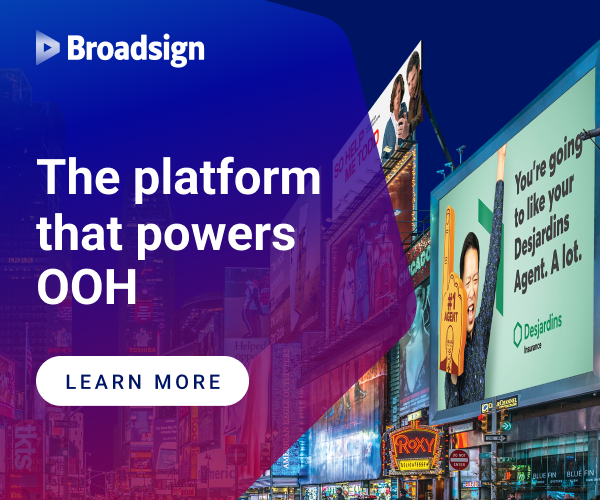State of the Industry: A Call for More Collaboration
Guest Contributor, Nancy Fletcher
OAAA President and CEO Nancy Fletcher delivered the annual “State of the Industry” report on May 8 at the 2018 Geopath/OAAA Out of Home Media Conference & Expo in Austin, TX. This Special Report is based on her remarks (reproduced with kind permission).
I want to celebrate with you the many OOH industry successes in the last year.
I’d also like to address one of the most pressing issues I see: the need for increased industry collaboration.
Industry Success
What a year we’ve had! One media writer said it best when he wrote, “OOH has gone from stepsister to hero; it is the rising star of traditional media.”
Every day, we’re in the news, and it’s good news about OOH’s effectiveness and creative impact.
 OOH even made it to the movies this year. A movie called Three Billboards Outside Ebbing, Missouri sparked a global movement and was nominated for seven Academy Awards. At this year’s Oscars, billboards stole the show. In his acceptance speech for Best Supporting Actor, Sam Rockwell thanked “anyone who’s ever looked at a billboard.”
OOH even made it to the movies this year. A movie called Three Billboards Outside Ebbing, Missouri sparked a global movement and was nominated for seven Academy Awards. At this year’s Oscars, billboards stole the show. In his acceptance speech for Best Supporting Actor, Sam Rockwell thanked “anyone who’s ever looked at a billboard.”
After the great year we’ve had, we too should be thanking everyone who has ever looked at OOH.
The OOH medium has never been bigger or better. Industry revenues have grown in 31 consecutive quarters, across all OOH formats, to a record $7.7 billion in 2017.
Tech and digitally-native brands like Amazon, Apple, Google, Hulu, Lyft, Microsoft, and Netflix are leading OOH advertisers. OOH is delivering a winning trifecta as technology, data, and infrastructure are coming together to enable better media campaigns for advertisers and better experiences for consumers.
Yet, there is another side to the story. Digital media’s share of overall ad spend rose 17 percent in 2017 to 45 percent market share, and it’s likely to grow, according to MAGNA. While OOH revenue is growing, share is stuck at 4 percent. Data analytics are transforming every corner of our industry. Innovations like augmented reality, artificial intelligence, autonomous vehicles, and Smart Cities are pending, and we must be prepared. And, factions within our industry potentially threaten continued success.
In this age of disruption, the future of OOH is going to be very different, whether we’re talking about measurement, data analytics, or automated buying and selling. We’re seeing new platforms and products, along with new competition, from outside our industry.
For more than a century, the OOH industry has adapted to all kinds of change and overcome challenges because of its proven model of vision, unity, and resolve:
- Standardizing ad formats
- Developing measurement standards
- Protecting property rights
- Rolling out digital formats and defending digital billboards in court
Now it’s time to tap into this same model of vision, unity, and resolve. It’s time to double down on industry collaboration.
And by that, I mean real collaboration, not just paying lip service to a lofty idea of teamwork. I’m talking about using our individual know-how – collectively – to build our competitive advantage as an industry.
Increased collaboration – inside the OOH advertising industry, with our customers, and the communities we serve — is a crucial building block to continued growth.
Collaboration Within Our Industry
 The OOH industry has been working together to position our medium for continued growth and prosperity. Last year we embraced a new vision, which comes from the industry positioning strategy to make OOH more of a core media buy.
The OOH industry has been working together to position our medium for continued growth and prosperity. Last year we embraced a new vision, which comes from the industry positioning strategy to make OOH more of a core media buy.
It’s not the content of our message that’s the challenge; our task is to get everyone aligned on the message and then ramp up the volume to tell our story in the strongest, most impactful way possible.
If you haven’t already, please get yourself aligned with the OOH Positioning. We should use every resource to tell OOH’s unprecedented story. We should all be working to convince clients, existing and new, that OOH deserves a bigger piece of the media pie.
New Ad Campaign
One promising way we can increase collaboration is to combine our resources, assets, and people to take our case directly to advertisers and agencies.
In 2015, the successful Feel the Real ad campaign started a conversation about the role of OOH and how it complements digital.
This year, we’ll execute a new industry-wide ad campaign. Publicis is the agency of record for OAAA. This new campaign will launch during Advertising Week New York this fall. Please join us in backing this campaign with contributions, inventory, and people.
Research
Another example of collaboration is pooling industry resources and expertise to prove the effectiveness of OOH.
By working with senior management, marketing, and research teams, OAAA commissions compelling third-party research on the value of OOH.
Last year we commissioned three new research studies demonstrating:
- OOH ROI outranks almost all competitive media
- OOH produces online activity better than all traditional media and web banner ads
- OOH posters are highly effective
This month we’re releasing new ROI research from Benchmarketing, and later this year new research will focus on the impact of OOH ads on consumer action.
Another important way we prove the value of OOH is through accurate industry statistics. One of the most important of these is ad spend data. Advertisers, trade press, and investors use ad spend data to inform their business decisions, so we want OOH to appear accurately and in the best possible light.
Media companies, if you haven’t done so, report your revenues and competitive data to OAAA, Kantar, and Miller Kaplan.
Industry Groups
Meanwhile, I call for more collaboration among the many groups that represent parts of our industry.
Collaboration is not about people attending each other’s conferences or serving on each other’s committees. It is about a willingness to have the tough conversations around where constituencies align their interests, where they diverge, and how to move forward in ways that are good for all but may not be the same for all.
I just spent three days at the Independent Billboard Operators’ conference in Jacksonville (IBOUSA), where we share common legal-legislative goals. OAAA has partnered with the Digital Place-Based Advertising Association (DPAA), Digital Sign Federation (DSF), Geopath and Interactive Advertising Bureau (IAB) to release new common standards for digital OOH. More collaboration like this should be a priority because it makes the industry stronger.
There should be more formal ties between industry organizations. Those of you who belong to more than one industry organization can get this done. Do it for our industry. Do it so OOH can speak with one voice to the media, to elected officials, and most importantly to our customers.
Collaboration with Customers
 Agency Visits
Agency Visits
Since 2013, OAAA has taken the OOH message on the road with visits to 400 agencies. We’re presenting the case for OOH in virtually every major market in America.
The learning process is mutual. Agencies tell us they want proof OOH generates results, streamlined-processes to plan and buy OOH, and audience measurement with enhanced data metrics.
We show them the brand-building power of OOH creative and explain how OOH drives online activity more effectively than any other traditional medium. We hear this common refrain: “I had no idea OOH has these capabilities.”
Celebrating Creative
Creative impact is a core OOH attribute and always cited as the number-one reason advertisers buy OOH. To reinforce this attribute, we’ve expanded the number of creative categories in the OBIE Awards. The vast majority of OBIE entries now come directly from agencies and brands.
We’ve also updated our online creative testing tool, which has been used more than 40,000 times by creative shops, brands, and OOH media companies.
OOH creative is so powerful – and our displays so visible – that we carry a special responsibility to our communities.
Collaboration with Communities
It’s collaboration with communities that determines how we are regulated and how our displays are perceived by the broader public. Since we operate in the public space, we have to rely on government permits and contracts to expand our footprint.
For decades, our state and federal regulatory work has been effective, and together we have amplified our voice far beyond one person or one company.
Constitutional Challenge
For the first time, the regulatory framework that governs billboards faces a constitutional challenge, on free speech grounds.
The industry is collaborating with government to defend existing billboard law, which includes fundamental protection of property rights. The US Department of Transportation, State of Tennessee, and OAAA are aligned in court, arguing that regulation of billboards and the First Amendment can co-exist.
Government Support
Government increasingly relies on OOH to support transit, build and maintain bus shelters, provide amenities such as free Wi-Fi and charging stations, and communicate with the public.
After Hurricane Harvey, OOH displays displayed FEMA emergency messages.
And last month, the FBI director presented a community leadership award to Clear Channel Outdoor Las Vegas for helping law enforcement after the mass shooting and also fighting human trafficking. This award symbolizes the industry’s long, effective partnership with law enforcement.
Connecting with Communities
We’re also collaborating in new ways to showcase our products and connect to our communities.
In the Winter Olympics this year, the first gold medal for Team USA was won by Red Gerard, a 17-year-old snowboarder born in Rocky River, Ohio. The following morning OAAA worked with a general manager in northeast Ohio to post congratulatory messaging to a digital billboard. US Sen. Sherrod Brown (D-OH) then shared a photo of that board with his 300,000 Twitter followers.
Congratulations to Red Gerard, who made all of Ohio – but especially his hometown of Rocky River – very proud this weekend, when he won America’s first gold medal of #PyeongChang2018. (photo via @YourOAAA)
In 2014 we collaborated with five premier art museums in Art Everywhere US, and the following years with the National Parks. Last year, we partnered with the respected global National Geographic Society, joining them in an effort to help save endangered species.
As we continue to develop new ways to connect with consumers and communities, we will surely face new challenges, challenges such as balancing privacy with the use of data. Collaboration with government and communities will remain a cornerstone of our ability to innovate, grow, and maintain goodwill.
OOH as a ‘Cultural Phenomenon’
This year, with the Three Billboards movie, OOH had its 15 minutes of cinematic fame. The role OOH plays in the public space, however, and in the national conversation has never been greater.
As the film gained popularity and esteem, it began to foster a cultural phenomenon. We’ve seen the “Three Billboards” tactic used around the world to give diverse opinions about gun control, domestic violence, tragic community events, and more. Black-on-red billboards became icons of expression.
The pull of these billboards was so strong, I couldn’t resist becoming a copywriter, to express my own views. I call it Three Billboards Outside Austin, Texas.
WITH COLLABORATION
COMES ACCELERATION
WHY NOT, OOH?

Conclusion
OOH has gone from stepchild to hero. It is the star of pop culture and the rising star of traditional media. Together, we’re looking out a window of opportunity, to continue to grow amidst vast change.
Increased collaboration – within our industry, with our customers, and with the communities we serve – is the best way I know to open that window and take advantage of that opportunity.







Follow DailyDOOH